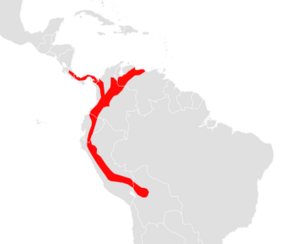Handley's tailless bat facts for kids
Quick facts for kids Handley's tailless bat |
|
|---|---|
| Conservation status | |
| Scientific classification | |
| Genus: |
Anoura
|
| Species: |
cultrata
|
 |
|
| Handley's tailless bat range | |
| Synonyms | |
|
Anoura brevirostrum |
|
Handley's tailless bat (Anoura cultrata) is a special type of bat found in parts of Central and South America. These bats belong to the family Phyllostomidae, which includes many different kinds of bats. You can find Handley's tailless bats in countries like Bolivia, Colombia, Costa Rica, Ecuador, Panama, Peru, and Venezuela. They are known for their unique features and important role in their ecosystems.
Contents
What is a Handley's Tailless Bat?
Handley's tailless bats are small, furry creatures that fly at night. They get their name because they have a very short tail, or sometimes no tail at all! These bats are usually dark brown or black. They have a long snout and a long tongue, which helps them drink nectar from flowers.
Where They Live
These bats live in different types of places, from forests to mountain areas. They prefer humid (wet) environments. You might find them in cloud forests or tropical rainforests. They often roost (rest) in caves or hollow trees during the day. At night, they fly out to find food.
What They Eat
Handley's tailless bats are mostly nectivores, which means they love to eat nectar from flowers. They also eat pollen and sometimes small insects. Their long tongues are perfect for reaching deep inside flowers to get the sweet nectar. As they feed, they help pollinate plants, just like bees do! This is super important for the health of the forest.
Bat Superpowers
Bats have amazing abilities that help them survive. Handley's tailless bats are no exception!
Echolocation
One of their coolest superpowers is echolocation. This means they send out high-pitched sounds that humans can't hear. When these sounds hit an object, they bounce back to the bat. The bat then uses these echoes to create a mental map of its surroundings. This helps them fly in the dark, avoid obstacles, and find food. It's like having built-in sonar!
Flying at Night
Because they use echolocation, Handley's tailless bats are nocturnal. This means they are active at night and sleep during the day. Flying at night helps them avoid predators that are active during the day. It also allows them to find flowers that open only at night.
Life Cycle
Like all mammals, Handley's tailless bats reproduce by giving birth to live young.
Reproduction
Female bats usually give birth to one baby bat, called a pup, at a time. The mother bat cares for her pup, feeding it milk until it is old enough to fly and find its own food. Baby bats grow quickly and soon learn to use their wings and echolocation.
Conservation
The Handley's tailless bat is currently listed as "Least Concern" by conservation groups. This means their population is stable and not currently at high risk. However, it's still important to protect their habitats. Losing forests and caves can be a big problem for all bats. By protecting their homes, we help ensure these amazing creatures can continue to thrive.
Images for kids
See also
 In Spanish: Anoura cultrata para niños
In Spanish: Anoura cultrata para niños



